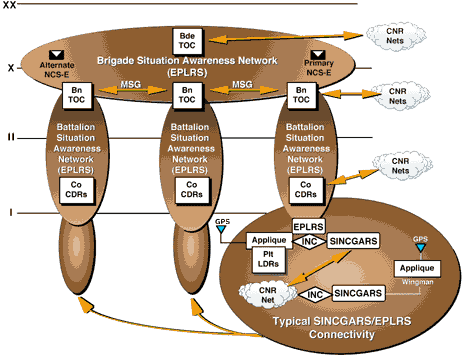One of the top priorities of the Army in digitizing the battlespace is to provide command and control capability throughout the force. This requires a horizontally and vertically integrated digital information network that supports warfighting systems and assures command and control decision cycle superiority. The network must provide reliable, seamless, and secure communications- connectivity for all Army tactical users
The Tactical Internet is the term used to describe this integrated battlespace communications network. The term is appropriate due to functional similarities to the commercial Internet and because the Tactical Internet communications
infrastructure is based on Internet technology. A key feature is the ability to exchange VMF messages using the commercially-based Internet Protocol (IP), which is mandated in the ATA and is common across all segments of the Tactical Internet.
At brigade and below, the Tactical Internet will extend the Army Battle Command systems to the soldier and weapons platform. The Tactical Internet passes battle command and situation awareness data. The Tactical Internet must provide tactical, mobile, simultaneous multi-band, multi-mode, voice and data (and possibly video) communications while providing routing and network services.
The initial digital communications system will consist of a space-based segment, an EPLRS-based backbone, a SINCGARS CNR segment, and a Mobile Subscriber Equipment/Tactical Packet Network (MSE/TPN) segment—all integrated via routers. The integrated digital transport capability of these communications segments is key to moving information among the Force XXI nodes and platforms. The communications infrastructure is focused on achieving seamless information transfer horizontally and vertically across the battlespace. This is achieved through the employment of commercial Internet technology (e.g., IP routers) and open standards protocols (e.g., TCP/IP). COTS IP-based routers (e.g., Tactical Multinet Gateways (TMGs) and Local Area Network (LAN) routers) and Internet Controllers (INCs)—which are single circuit card, militarized Internet-based routers—provide the ability to send messages between any segment of the tactical battlespace network. While INCs are physically incorporated into a SINCGARS mount, they provide a host and an EPLRS interface, as well as a SINCGARS interface.
Enhanced versions of the three primary Army tactical communications system segments—EPLRS, SINCGARS, and MSE/TPN-will move the ever-increasing amount of digital data associated with command and control applications employed within the modern battlespace. Capabilities will also exist to interface the Tactical Internet to commercial and military satellite communications (SATCOM), providing unprecedented capacity and access to lower–echelon units.
The Tactical Internet supports several key services. These services include functions such as electronic messaging, directory, network management, and security. These services are integral to the value of the Tactical Internet in support of the warfighter. As new host-based services are added—such as DMS electronic mail service—their supporting system components will be folded into the Tactical Internet.

Security is an important service within the Tactical Internet. Because of the concern for security, the Tactical Internet will initially be operated as a SECRET High system. Since all directly-connected host computers will be capable of operating up to the Secret level, direct connections to the commercial Internet cannot be permitted. There is, however, a great deal of interest in the new end-to-end encryption devices that will permit Unclassified users to use the SECRET High Tactical Internet to access Unclassified computers connected to the commercial Internet. This capability is of particular importance to CSS users, who typically use Unclassified applications and data, and need to communicate in a split-based mode with large computer systems in CONUS. The availability of multi-level security services will enable greater network flexibility. As these services are realized and integrated into the Tactical Internet, the issue of a SECRET High network infrastructure will be revisited.
Another key component of the Tactical Internet is technical control. The Integrated Systems Control (ISYSCON) program is developing the capability to technically control networks at brigade-and-above level. Since TMGs and INCs must also be technically controlled, additional ISYSCON capabilities in the form of Automatic Network Managers (ANMs) are being added to control the Tactical Internet at brigade-and-below. The management protocol for the ANM will be Simple Network Management Protocol (SNMP), with SNMP agents implemented by communications elements. In some cases, however, proxy agents will be used (e.g., SINCGARS and EPLRS proxy agents will be hosted on the applique).
The Signal Center (SIGCEN), in conjunction with CECOM, is investigating the operational and training impact of the Tactical Internet. A series of BLWEs, AWEs, and Joint Warfighter Interoperability Demonstrations (JWIDs) will provide an experimental basis to:
PEO C3S, with the support of CECOM and SIGCEN, is responsible for developing the Tactical Internet in accordance with the SA.
Improvements to components comprising the SA are needed to make the Tactical Internet viable. The use of commercial Internet protocols provides the required level of seamless connectivity between the different networks, but Internet protocols increase data capacity requirements because additional header information must be added to each message. The Internet routers exchange routing and status information, which also increases data capacity requirements. Even with the improved data capacity of SINCGARS, EPLRS, and MSE, these systems provide relatively small communications trunks compared to fixed-site commercial systems. A comprehensive modeling and simulation effort is therefore required to determine the optimum parameters for the use of Internet protocols in a dynamic military environment featuring relatively few communication links.


